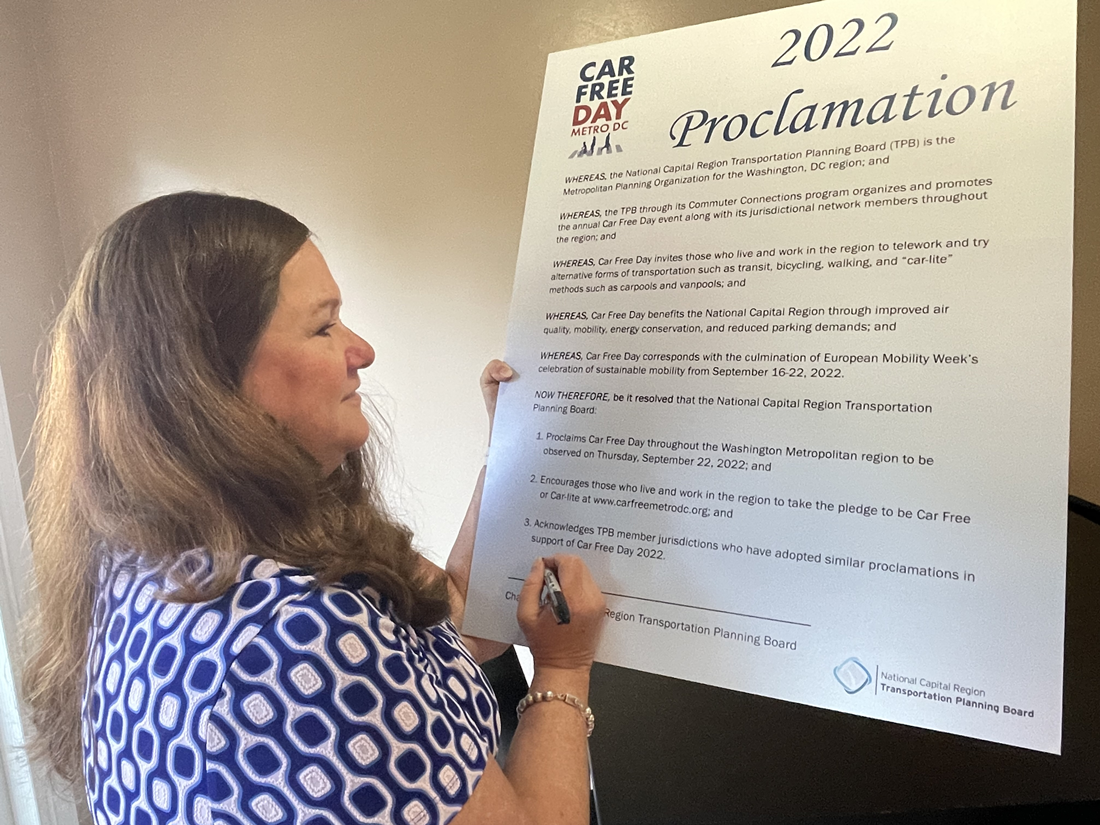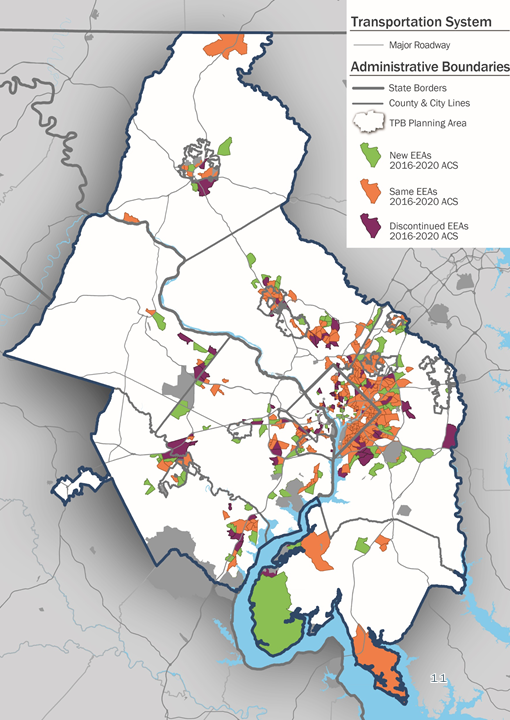TPB Approves Maryland Transportation Alternatives Set-Aside Program funding for F&PL Trail in Frederick County and Reviews Equity Emphasis Areas Updates
At the July meeting, Transportation Planning Board members approved Maryland Transportation Alternatives Set-Aside Program (TAP) funding for the Frederick & Pennsylvania Line (F&PL) Railroad Trail, received a report on map updates to the Metropolitan Washington Council of Governments-adopted Equity Emphasis Areas based on the most recent American Community Survey data, and approved the proclamation of September 22 as Regional Car Free Day—an event to encourage residents to go car free by using public transit, bicycling, walking, scooting, or by telecommuting.
Meeting Agenda, materials, and recording.
ACTION ITEMS
Maryland FY 2023 Transportation Alternatives Set Aside Program
John Swanson, TPB Transportation Planner, presented the recommendation that the TPB approve $5.1 Million in Surface Transportation Block Grant Transportation Alternatives Set-Aside Program funding for the construction of a 1.79 mile-segment of the Frederick and Pennsylvania Line (F&PL) Trail in Frederick County, Maryland. The TPB voted to approve Resolution R1-2023 to move forward with the project.
The 10-foot F&PL asphalt trail will run adjacent to the railroad tracks from Monocacy Boulevard in the City of Frederick to Fountain Rock Nature Center in Walkersville, Maryland, providing access to a Maryland Department of Transportation (MDOT) park and ride lot and local Maryland Transit Administration (MTA) commuter bus service. In addition, the F&PL Trail will link to the National Capital Trail Network.
Seven projects were submitted for funding. After much discussion, the project review panel recommended that TPB approve funding for the complete F&PL project and requested that the TPB encourage MDOT to use statewide Transportation Alternatives funds to prioritize the following projects:
- Twinbrook Safe Routes to School and Transit Access Feasibility Study, City of Rockville
- West 7th Street Protected Bicycle Lane 100% Design, City of Frederick
- Traffic Calming Feasibility Study - Catoctin Furnace National Register Historic District Frederick County
- Downtown Connectivity Study City of Frederick
College Park City Council Mayor Patrick Wojahn expressed interest in the TPB tracking the possibility of expanding technical assistance for local jurisdictions interested in developing projects and applying for TAP funding in the future. A potential source is a five percent technical assistance set-aside included in the Infrastructure Investment and Jobs Act (IIJA). Takoma Park City Councilmember Kacy Kostiuk said that she would like to learn more from MDOT about a current state rule that TAP projects cannot be partially funded and discuss how that might limit funding smaller scale projects that need support and assistance. TPB staff agreed to follow up with MDOT to address both questions.
Regional Car Free Day 2022
TPB Chair Pamela Sebesky signed a proclamation on behalf of TPB members declaring September 22, 2022, as Car Free Day for the National Capital Region. Travelers can take a pledge to go car free or “car lite” by visiting www.CarFreeMetroDC.org. The 2022 goal is to have 5,000 individuals take the pledge. Promotional materials and social media posts are coming soon. Follow @NatCapRegTPB, #CarFreeDay, and #CarFreeMetroDC to stay up to date between now and September 22.

TPB Chair Pamela Sebesky signs the 2022 Car Free Day Proclamation
Source: TPB
INFORMATIONAL ITEM
Visualize 2045 Environmental Justice Analysis: Equity Emphasis Area Updates
A TPB Transportation Planner presented on the July 2022 update of the region’s Equity Emphasis Areas (EEAs) based on the most recent American Community Survey census data. EEAs, in brief, are small geographic areas with higher concentrations of low-income, Black or African American, Hispanic or Latino, and/or Asian populations. Updated EEAs will be used to conduct a federally required Environmental Justice (EJ) analysis of the recently approved Visualize 2045 Long-Range Transportation Plan and are regularly used for planning purposes to help TPB and member jurisdictions understand the impact of transportation plans, policies, and projects on EEAs compared to other parts of the region.
Key takeaways from the 2022 update:
- 364 of the region’s more than 1,330 census tracts are designated EEAs
- EEAs represent 27 percent of all tracts in the region (compared to 29 percent in 2018)
- No significant change in the overall pattern of distribution of EEAs in the region
- No significant change in the overall composition of population groups within the EEAs

Change in Equity Emphasis Areas (2012-2016 ACS to 2016-2020 ACS)
Source: TPB
The EEA update is Phase I of the federally required EJ analysis of Visualize 2045. Phase 2 is an analysis of the 2022 Visualize 2045 Long-Range Transportation Plan Update to determine if the implementation of projects in the plan would have a disproportionately high and significantly adverse impact on low-income or traditionally disadvantaged racial and ethnic populations. If significant impacts are found, the TPB would need to identify mitigation measures. TPB staff expects to present the results of the Phase 2 analysis in fall 2022. As an additional note of interest, the use of EEAs within COG extends beyond transportation. The COG Board of Directors has adopted EEAs into other regional planning efforts such as land use, housing, public health, and food availability. An interactive EEA map with the latest data is available on the COG site.
Sakina Khan, District of Columbia Office of Planning Deputy Director of Citywide Strategy & Analysis, commented that she looks forward to the next phase of the analysis and implications for the District. “We do use the Equity Emphasis Areas as part of our planning work. It helps us think about the relationship to the variety of planning that we're doing and other opportunities, such as linkages to infrastructure.”
Kostiuk asked what mitigation steps would take place if an issue is found during the EJ analysis. TPB Staff Director Kanti Srikanth provided additional information about mitigation. Large projects, particularly those that require federal approval or that rise to the level of needing environmental impact statements, require assessments to determine what impacts the projects might have. As part of these assessments, mitigation efforts must be identified. Srikanth noted that as TPB member jurisdictions develop projects for the plan, they also have an opportunity to think about potential inequities before projects are finalized. He said that the MPO EJ analysis, on the other hand, assesses the impact of the long-range plan as a whole.
Looking at the combination of highway, transit, and non-motorized transportation projects determines whether there is a disproportionate impact on mobility and accessibility for low-income and traditionally disadvantaged racial and ethnic population groups in the region relative to the impacts on the rest (non-equity emphasis areas) of the planning area. Srikanth said that to date the TPB long-range plans have not demonstrated inequitable impacts on EEAs and should this next phase of the analysis indicate any such inequities from the 2022 Visualize 2045 plan, then the board would collectively discuss ways to mitigate such impacts.
Committee and Director’s Reports
TPB Technical Committee and Community Advisory Committee (CAC) reports are available on the July 20 TPB Meeting page.
Joint CAC – TPB Meeting Report
CAC Chair Ashley Hutson reported on a special July 14 joint meeting with TPB Officers Pamela Sebesky, Reuben Collins, and Christina Henderson and TPB member Kacy Kostiuk. The meeting consisted of a general discussion about regional topics and breakout discussions for the District of Columbia, Maryland, and Virginia. Hutson reported that the District discussion centered on street safety, support for bike lanes, WMATA ridership, and electric vehicle charging. Participants in the Maryland breakout discussed outer jurisdiction needs, support for transit to suburban locations, support for TPB climate initiatives, and transportation’s effect on attracting businesses to Maryland. The Virginia breakout discussion centered on multimodal options, outer jurisdiction support for inner jurisdictional plans to expand transit and walking, and making short-term transportation improvements for operability.
During follow-up comments, Sebesky encouraged TPB members to reach out to CAC members in their jurisdictions to find out their goals for participation in the committee, how their goals relate to TPB goals, and to invite CAC members to come before jurisdictional bodies to report on CAC activities. Sebesky recommended that the TPB continue to meet with the CAC on an annual basis.
Collins said that he thought the meeting was a great opportunity to understand the scope of the TPB and relationship with CAC. It was also a chance to express goals and aspirations on a regional level and an educational opportunity. Henderson said that she appreciated joining the CAC meeting for the feedback opportunity and to hear cross-jurisdiction questions. Kostiuk encouraged TPB members to join future meetings with the CAC to learn more about the committee and also stated that it was a great opportunity to connect and find ways to work together.
Director's Report
Srikanth informed the TPB that on July 8 TPB Steering Committee members adopted a resolution supporting submission of 45 Northern Virginia highway, transit, and bicycle and pedestrian projects into the Virginia Department of Transportation’s SMART SCALE project prioritization process. Local agencies located within the region are required to submit to VDOT a letter of support from the MPO. The committee also received copies of letters documenting completion of the Final Environmental Impact Statement and final Section 4f evaluation for the three segments of the Maryland I-495 and I-270 Managed Lanes project and an MDOT update on transit improvements planned as part of the Phase I South of Op-Lanes Maryland project.
Srikanth thanked Collins for emceeing the 2022 Commuter Connections Employer Recognition Awards and Sebesky for presenting TPB awards at the ceremony. The annual awards recognize employers that implement commute alternative programs and offer telecommuting opportunities.
In response to a question from Falls Church City Councilmember David Snyder, Srikanth reported that TPB and COG staff are in the process of cataloging how the TPB currently monitors and reports on greenhouse gas reduction strategies as part of next steps for working toward the reduction goals adopted by the TPB in June 2022. Additional information will be provided to the TPB as the process moves forward.
NEXT MEETING
The next TPB meeting is scheduled for September 21 at 12:00 P.M. and will be virtual only. A YouTube livestream option will be available.